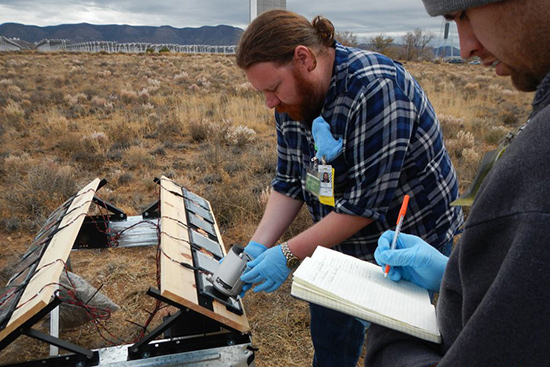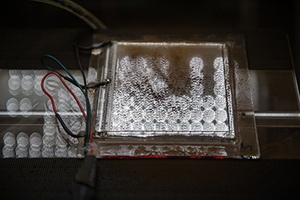Are Solar Panels In California Self Cleaning
Get-go, one astonishing fact from the U.s. Department of Energy: the free energy from the sun that hits the Globe in a single hour could power the planet for an entire twelvemonth.
Unsurprisingly, 1 of the best places to harness that abundant and environmentally friendly energy is a desert, merely it turns out that deserts almost e'er come up with a nemesis to solar panels: sand. The particulate thing that constantly blows across deserts settles on solar panels, decreasing their efficiency. The current method used to keep solar panels dust-free requires people to spray the grit off with desalinated, distilled water.
"That might not audio similar a big bargain, but if you accept millions of square feet of solar panels out in a desert, it ends up being costly—especially if water is a deficient resource," says John Noah Hudelson (ENG'14), one of several BU graduate students working to detect a better solution. The squad'southward reply, called a transparent electrodynamic system (EDS), sets upward an electrostatic field on the solar panels, causing grit particles to levitate, dipping and rising in alternate waves (the way a embankment brawl bounces forth the upturned hands of fans in a packed stadium) every bit the electrical charge fluctuates. In its final version, the EDS, which tin can exist embedded in a transparent film, will be programmable or will automatically detect the presence of surface grit and switch on. The entire process takes seconds, and uses a minuscule corporeality of power, generated by the solar device itself—about ane/100th of what it produces daily.
"There's nothing like this on the market," says Mark Horenstein, a Higher of Engineering professor of electric and reckoner engineering, who is working on the project with Malay Mazumder, an ENG inquiry professor of electrical and computer engineering and of materials science and applied science.

Doctoral candidate Jeremy Stark (left) and graduate student John Noah Hudelson take a specular reflection reading last year on mirrors they installed at Sandia National Laboratories in Albuquerque, N.M. Photo courtesy of Jeremy Stark
The inspiration for the EDS came to Mazumder from an unlikely source: human lungs. He remembers thinking that the cocky-cleaning hairs that sweep dust upwardly and out of the respiratory system were "ingenious defense mechanisms." He idea he could mimic that tidy biological system and apply it elsewhere.
In 2003, NASA, whose scientists idea the engineering had promise for future Mars missions, gave him a three-year, $750,000 grant. When that funding expired, a $fifty,000 Ignition Award from BU'due south Technology Development office kept Mazumder's inquiry afloat. His large break came in 2010, when he gave a presentation on the EDS at an American Chemical Society conference in Boston. News of the technology spread through articles in such publications every bit the New York Times.
Mazumder got a call from David Powell, a research and development manager at Abengoa Solar, a global pioneer in the construction of CSP (full-bodied solar power) and PV (photovoltaic) power plants. The visitor operates the Solana Generating Station in Gila Bend, Ariz., and the soon-to-open up Mojave Solar Projection almost Barstow, Calif. Each has the capacity to produce 280 megawatts—sufficient to ability more than 100,000 homes. With at least two plants in desert locations, Abengoa was keenly interested in the success of the EDS and eager to test Mazumder's prototypes.

Inside seconds, the transparent system sweeps away at least ninety percent of dust particles and sand on a solar panel. Photo by Jackie Ricciardi
In 2012, Mazumder and Abengoa landed a two-year, $945,000 grant from the Department of Energy (DOE) Office of Energy Efficiency and Renewable Energy to farther test and expand the chapters of the EDS. Horenstein and Nitin Joglekar, a Schoolhouse of Management acquaintance professor of operations and technology management, are coprincipal investigators of the grant, and Sandia National Laboratories in Albuquerque, N.M., signed on to help evaluate the prototype's efficiency and develop larger-scale models. With a $forty,000 grant from the Mass Clean Energy Council, the squad's total funding rose to nearly $i million.
For two months final year, Hudelson and doctoral candidate Jeremy Stark (ENG'14) tested nearly xx EDS prototypes at the Abengoa and Sandia sites before rain and snowfall cut their work short. They found that the system performed as expected, removing at least 90 pct of dust particles from solar panel surfaces. Next, the BU team must effigy out how to protect the EDS from Mother Nature and how to upscale to industrial-sized models.
Mazumder is meeting with manufacturers who can scale upwards the models, and with representatives of the DOE, which may provide some boosted funding for the project. He believes that the self-cleaning system could hit the market within the next three years.
Source: https://www.bu.edu/bostonia/summer14/self-cleaning-solar-panels/
Posted by: morenogiss1998.blogspot.com


0 Response to "Are Solar Panels In California Self Cleaning"
Post a Comment